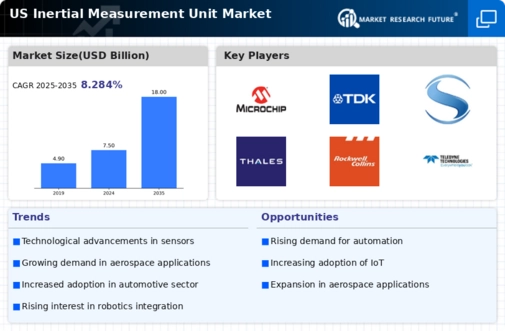Expansion of Consumer Electronics
The consumer electronics sector is experiencing a notable expansion, which is likely to drive the inertial measurement-unit market significantly. With the proliferation of smartphones, tablets, and wearable devices, the demand for compact and efficient inertial measurement units is on the rise. These devices utilize inertial sensors for various applications, including motion tracking and augmented reality. In 2025, the market for inertial measurement units in consumer electronics is estimated to be valued at around $800 million, showcasing a growth trajectory of approximately 12% annually. This growth suggests that as consumer preferences evolve, the inertial measurement-unit market will continue to adapt and innovate to meet the needs of this dynamic industry.
Increased Adoption of Autonomous Systems
The rise of autonomous systems across various sectors appears to be a pivotal driver for the inertial measurement-unit market. Industries such as aerospace, defense, and robotics are increasingly integrating inertial measurement units to enhance navigation and control systems. The demand for precision in autonomous vehicles, drones, and robotic applications is propelling the market forward. In 2025, the market for inertial measurement units in autonomous systems is projected to reach approximately $1.5 billion, reflecting a growth rate of around 15% annually. This trend indicates a robust need for advanced inertial measurement technologies, which are essential for the accurate positioning and orientation of autonomous systems.
Integration of IoT in Industrial Applications
The integration of Internet of Things (IoT) technologies in industrial applications appears to be a transformative driver for the inertial measurement-unit market. Industries are increasingly adopting IoT solutions to enhance operational efficiency and data analytics, which often require precise motion sensing capabilities. In 2025, the market for inertial measurement units in industrial IoT applications is anticipated to reach approximately $600 million, reflecting a growth rate of around 10% annually. This trend suggests that as industries continue to embrace digital transformation, the demand for inertial measurement units will likely increase, facilitating improved monitoring and control processes across various sectors.
Rising Demand for Enhanced Navigation Systems
The rising demand for enhanced navigation systems across multiple sectors is likely to propel the inertial measurement-unit market. As industries such as transportation, aerospace, and maritime seek to improve accuracy and reliability in navigation, the need for advanced inertial measurement units becomes increasingly critical. In 2025, the market for inertial measurement units in navigation applications is projected to be valued at approximately $1.2 billion, indicating a growth rate of around 14% annually. This trend suggests that advancements in navigation technologies will continue to drive innovation and investment in the inertial measurement-unit market, as stakeholders prioritize precision and efficiency in their operations.
Government Investments in Defense Technologies
Government investments in defense technologies are likely to serve as a significant driver for the inertial measurement-unit market. The U.S. defense sector is increasingly focusing on advanced navigation and targeting systems, which rely heavily on inertial measurement units for accuracy and reliability. In 2025, defense spending is projected to exceed $800 billion, with a substantial portion allocated to research and development of advanced technologies. This trend indicates a growing reliance on inertial measurement units in military applications, potentially leading to a market valuation of over $1 billion in this sector alone. The emphasis on enhancing national security and operational efficiency is expected to further stimulate demand for these critical components.























Leave a Comment